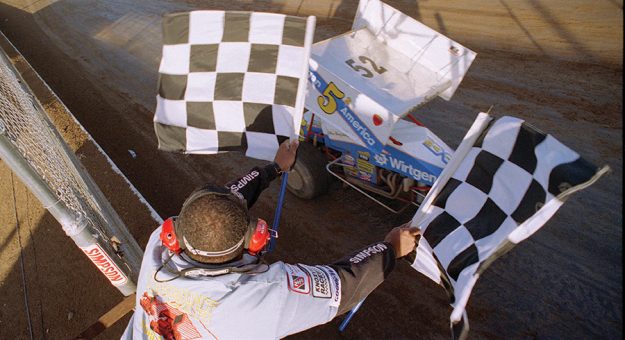“I said, ‘Mike, I have the craziest idea you have ever heard,‘” Patterson continued. “He said, ‘Let me hear it.‘ The next call was to Dr. Dick Berggren, and remember he was also the editor of Stock Car Magazine at the time. When I told him what I was doing, he was all about it.”
With two high-profile announcers in the booth, he turned to Jeff Swindell to serve as the color analyst. Needing someone to roam the pits, Patterson had an epiphany.
“There was this young guy we had been using to do some voice overs who knew a lot about motorcycles,” Patterson said. “But he also knew a lot about sprint cars. His name was Ralph Sheheen, and everybody signed off on him.”

Sheheen remembered the day he got the call.
“I had moved to Charlotte in 1990 and one of the first people I worked for was Pat,” he said. “He had his On Pit Road television show and that developed into RaceDay on TNN. He was looking for cost-effective help right away and as a new kid in town I was certainly willing to do about anything to get my career going.”
Sheheen felt was right in his wheelhouse.
“I was giddy,” he said. “I grew up in Northern California and winged 410 sprint car racing was near and dear to my heart. That is really what kick-started my career in a lot of ways. So when the Slick 50 Series started, it was like, ‘Oh man, are you kidding?‘ First there would be 10 straight weeks of payment, which was huge and I got to do it with sprint cars and at a time when there really wasn‘t anything else going on.”
Still the anxiety was high.
“We had enough money to do what we were doing that day,” Patterson said. “But if anything went wrong, we might be out of business next week. It was that close. It was a complete team deal. You never really understood going in how many logistical things could go wrong and how many logistical things needed to go right.”
Patterson was deeply concerned about the competitors supporting the event.
“I was as nervous as you could possibly be,” he explained. “You would hear through the grapevine that (Dave) Blaney was coming, or Jeff would say his brother would be there.
But you really didn‘t know. So the biggest thrill in the first round of this thing was coming to the race track the day before and there were like 25 haulers sitting there.

“I was like, they are actually coming to race in this thing,” he continued. “It was like that one moment when you realized, hey man you are going to have a real sprint car race with real people that make it happen throughout the year. It just blew me away, but I knew that there were people who desperately wanted sprint car racing to be on live television.”
The early winners were a who‘s who in the sport with Sammy Swindell, Steve Kinser, Jac Haudenschild and Mark Kinser winning in sprint cars. Midget winners were equally star-studded, with Sammy Swindell, Ron Shuman and Page Jones triumphing.
Then the rain came. That wasn‘t supposed to happen in Arizona.
“It was the biggest financial hit of my life.” Patterson said. “I have a panoramic picture of Manzanita Speedway in my office to this day. From the road it looks like there was a real lake that leads up to a boat dock. People look at that picture all the time and say, ‘Where did you get that?‘ I always say I paid $150,000 for it. And I did.”
Whatever fiscal success could have come in the first year of the series went right out the window. Still there was great pride in what was accomplished.
After a year at Manzanita the series moved to Canyon Speedway in Peoria, Ariz.
Canyon presented a new set of obstacles. First, there was little infrastructure in place. Additionally, the dust and wind was even more of a challenge, but Patterson had a veteran crew of professionals who were committed to the project.
With Jeff Swindell itching to get back in a race car, Patterson called on Brad Doty as analyst. It had been four years since Doty had been paralyzed in a crash at Ohio‘s Eldora Speedway.
